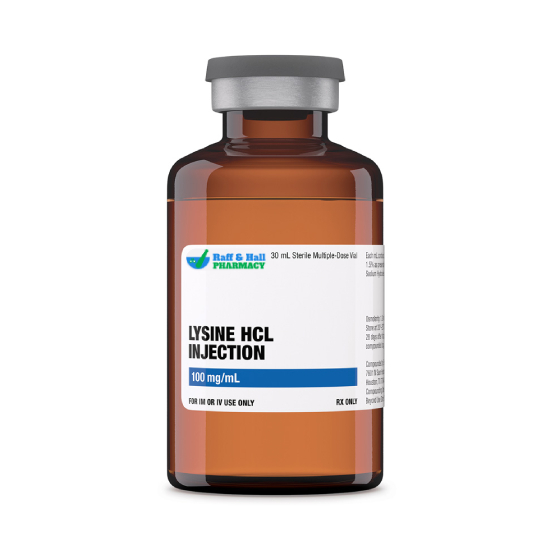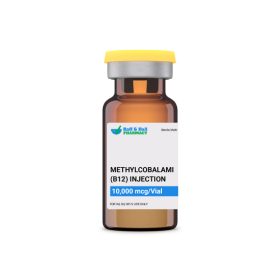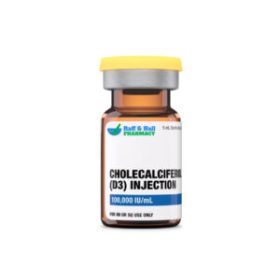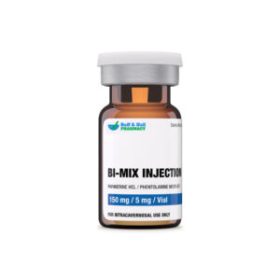This product is available through our 503A Compounding Pharmacy, ensuring versatile solutions tailored to meet your needs. If you do not have an account, please contact us.
Lysine HCl Injection (30 mL Vial)
Lysine HCl Injection is a sterile injectable form of the essential amino acid lysine, commonly used to support protein synthesis, promote collagen formation, and enhance calcium absorption. It may be administered as part of nutritional support in individuals with lysine deficiency or increased metabolic needs, such as during recovery from trauma, burns, or surgery. Lysine is also sometimes used to help manage or prevent outbreaks of herpes simplex virus due to its role in inhibiting viral replication.
Mechanisms of Action
Lysine functions as a building block for proteins and is vital for tissue repair, enzyme production, and hormone synthesis. It also plays a role in the absorption of calcium and may help in the formation of collagen, which supports skin, bones, and connective tissues. Lysine can inhibit the activity of arginine, another amino acid that certain viruses (like HSV) require for replication, thereby potentially reducing the frequency and severity of outbreaks.
Contraindications & Precautions
Lysine HCl Injection is generally well tolerated, but it should not be used in individuals with known hypersensitivity to lysine or any component of the formulation. Caution is advised in patients with kidney or liver impairment, as altered amino acid metabolism could occur. Electrolyte levels and renal function should be monitored during prolonged use. It should be used under the supervision of a healthcare professional, especially when administered intravenously.
Interactions
Lysine may interact with calcium supplements or medications affecting calcium metabolism, potentially increasing calcium absorption and the risk of hypercalcemia. There are no major drug interactions reported, but it’s always important to inform the healthcare provider about all medications, supplements, or treatments being taken concurrently.
Adverse Reactions / Side Effects
Side effects are generally mild and uncommon. Possible reactions may include nausea, abdominal cramps, or diarrhea. When administered by injection, local irritation, redness, or pain at the injection site may occur. Rarely, allergic reactions such as rash or itching may develop.
Pregnancy & Breastfeeding
Lysine is considered likely safe during pregnancy and breastfeeding when taken in dietary amounts. However, the safety of lysine in injectable form during pregnancy and lactation has not been thoroughly studied. Use should be based on clinical judgment, and only when clearly needed under medical supervision.
Store this medication at 68°F to 77°F (20°C to 25°C) and away from heat, moisture and light. Keep all medicine out of the reach of children. Throw away any unused medicine after the beyond use date. Do not flush unused medications or pour down a sink or drain.
- D. Tomé and C. Bos, “Lysine Requirement through the Human Life Cycle,” J. Nutr., vol. 137, no. 6, pp. 1642S-1645S, Jun. 2007.
- E. Volpi, A. A. Ferrando, C. W. Yeckel, K. D. Tipton, and R. R. Wolfe, “Exogenous amino acids stimulate net muscle protein synthesis in the elderly.,” J. Clin. Invest., vol. 101, no. 9, pp. 2000–2007, May 1998.
- S. H. Kim, Y. kyung Chung, J. Y. Chang, S. K. Lee, M. S. Lee, and S. K. Park, “Stable liquid formulation of human growth hormone,” US8409586B2.
- F. Papes, M. J. Surpili, F. Langone, J. R. Trigo, and P. Arruda, “The essential amino acid lysine acts as precursor of glutamate in the mammalian central nervous system,” FEBS Lett., vol. 488, no. 1–2, pp. 34–38, Jan. 2001.
- R. Civitelli, D. T. Villareal, D. Agnusdei, P. Nardi, L. V Avioli, and C. Gennari, “Dietary L-lysine and calcium metabolism in humans.,” Nutrition, vol. 8, no. 6, pp. 400–5.
- E. L. J. Bonner and R. Hines, “Method for treatment of reactive arthritis or bursitis,” US6765000B2, 2004.
- K. Gerzon, “Herpes treatment,” US4415590A, 1983.
- M. Singh et al., “Medicinal Uses of L-Lysine: Past and Future,” Int. J. Res. Pharm. Sci., vol. 2, pp. 637–642, 2011.
- C. Wass et al., “L-lysine as adjunctive treatment in patients with schizophrenia: a single-blinded, randomized, cross-over pilot study.,” BMC Med., vol. 9, p. 40, Apr. 2011.
- N. W. Flodin, “The metabolic roles, pharmacology, and toxicology of lysine.,” J. Am. Coll. Nutr., vol. 16, no. 1, pp. 7–21, Feb. 1997.
- T. Kato, M. Sano, and N. Mizutani, “Inhibitory effect of intravenous lysine infusion on urea cycle metabolism,” Eur. J. Pediatr., vol. 146, no. 1, pp. 56–58, Jan. 1987.
- S. Guo and L. A. Dipietro, “Factors affecting wound healing.,” J. Dent. Res., vol. 89, no. 3, pp. 219–29, Mar. 2010.
- K. F. Harlow, “L-Lysine Hydrochloride: An Alternative Prophylactic Therapy Reducing the Recurrence Rate of Herpes Labialis,” Pacific University, 2015.
- R. S. Griffith, D. C. DeLong, and J. D. Nelson, “Relation of Arginine-Lysine Antagonism to Herpes simplex Growth in Tissue Culture,” Chemotherapy, vol. 27, no. 3, pp. 209–213, 1981.
- F. Vuvor and T. Ndanu, “Effect of lysine supplementation on cardiovascular response to stressors of households in two peri-urban communities in Ghana,” J. Heal. Res. Rev., vol. 3, no. 3, p. 92, 2016.
- W. G. Walker, H. Dickerman, and L. J. Jost, “Mechanism of lysine-induced kaliuresis,” Am. J. Physiol. Content, vol. 206, no. 2, pp. 409–414, Feb. 1964.
- V. J. Mailoo and S. Rampes, “Lysine for Herpes Simplex Prophylaxis: A Review of the Evidence.,” Integr. Med. (Encinitas)., vol. 16, no. 3, pp. 42–46, Jun. 2017.
- M. Lukkarinen, K. Näntö-Salonen, K. Pulkki, K. Mattila, and O. Simell, “Effect of lysine infusion on urea cycle in lysinuric protein intolerance,” Metabolism, vol. 49, no. 5, pp. 621–625, May 2000.
- R. Elango and R. O. Ball, “Protein and Amino Acid Requirements during Pregnancy,” Adv. Nutr. An Int. Rev. J., vol. 7, no. 4, pp. 839S-844S, Jul. 2016.
- M. Payne, T. Stephens, K. Lim, R. O. Ball, P. B. Pencharz, and R. Elango, “Lysine Requirements of Healthy Pregnant Women are Higher During Late Stages of Gestation Compared to Early Gestation,” J. Nutr., vol. 148, no. 1, pp. 94–99, Jan. 2018.
- L. Bumpstead, “Long-term use of supplemental lysine – is it safe?,” J. Aust. Tradit. Soc., vol. 19, no. 4, pp. 228–231, 2013.
- P. J. Garlick, “The Nature of Human Hazards Associated with Excessive Intake of Amino Acids,” J. Nutr., vol. 134, no. 6, pp. 1633S-1639S, Oct. 2004.





